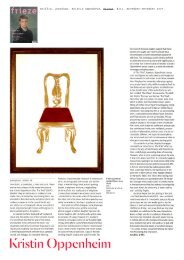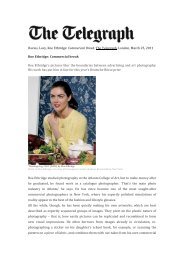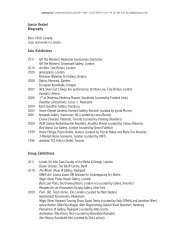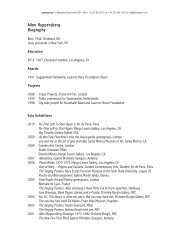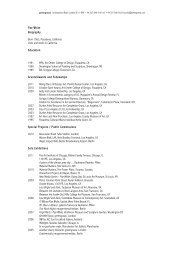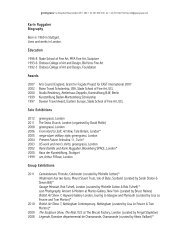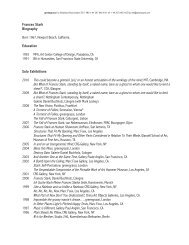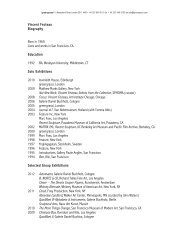Teasdale, Paul, Moyra Davey, Frieze, #44, London ... - Greengrassi
Teasdale, Paul, Moyra Davey, Frieze, #44, London ... - Greengrassi
Teasdale, Paul, Moyra Davey, Frieze, #44, London ... - Greengrassi
Create successful ePaper yourself
Turn your PDF publications into a flip-book with our unique Google optimized e-Paper software.
BEST BOOKS OF 2008<br />
SHANNON EBNER<br />
If a writer’s style can be characterized as<br />
photographic, then this is how I would refer to<br />
<strong>Moyra</strong> <strong>Davey</strong>’s stylistic approach in her essay<br />
“Notes on Photography & Accident.” Published on<br />
the occasion of the artist’s first museum exhibition<br />
(at Harvard’s Fogg, curated by Helen<br />
Molesworth), Long Life Cool White is a small,<br />
elegantly designed paperback that neither feels<br />
nor reads like a typical catalogue.<br />
<strong>Davey</strong>’s writing is scholarly while never losing sight of a more personal and notational expository<br />
drift. And it is precisely this drift that grants her prose its photographic quality. Taking up the<br />
question of whether the notion of accident may hope to retain its relevance, <strong>Davey</strong> looks to<br />
Roland Barthes, Walter Benjamin, Susan Sontag, and Janet Malcolm, each of whom has mined<br />
this history of analog slippages in his or her texts. Through their writing, <strong>Davey</strong> locates<br />
precedence for a renewed interest in the camera’s mechanical mishaps. One gets the sense that<br />
<strong>Davey</strong>, in casting herself into the interstitial spaces of thought, is not so much thinking about<br />
things as thinking between them. As an example, among <strong>Davey</strong>’s notes are ideas about<br />
photography’s ascending market value and correlative expansion of scale; Benjamin’s idea of the<br />
optical unconscious in relation to psychoanalysis; <strong>Davey</strong>’s own declining health; and, finally,<br />
thoughts on the drive to take photographs in the “real,” as opposed to the imagined (read: staged)<br />
world at all. Definitive conclusions are not necessarily what <strong>Davey</strong> values.<br />
What readers may find of value, however, are <strong>Davey</strong>’s photographs, in particular her<br />
“Copperheads” series, 1990–92. Here, the distressed surfaces of pennies, the lowliest form of<br />
currency, are surveyed by the camera’s uncompromising lens, investing the cent with the exploits<br />
of visual information not commonly bestowed upon it.<br />
Perhaps what struck me most about this book was <strong>Davey</strong>’s low-grade anxiety about analog<br />
photographic technologies on the cusp of obsolescence. In her summary of the quotes (from<br />
Barthes, Sontag, et al.) that began her journey into the topic of “Photography & Accident,” <strong>Davey</strong><br />
formulates the proposition that “accident is the lifeblood of photography.” If we are to accept this<br />
claim, one may ask, what will it mean for the medium when photography loses touch with the<br />
analog—which requires, at the very least, an actual subject, even if inanimate—and so<br />
surrenders some control to the fate of a mechanical camera? Will photography be leached of life,<br />
or will the notion of accident merely undergo a radical redefinition? In medias res, this pun is<br />
intended.<br />
Shannon Ebner is an artist based in Los Angeles.




